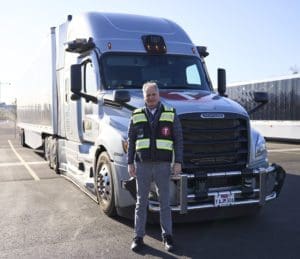
In 2022, Torc Robotics – a provider of autonomous trucks for the middle mile – and Daimler Truck, who is the majority owner of Torc, held an event for journalists and financial analysts at a Torc facility in Albuquerque. At the time, some of Torc’s competitors were claiming that they would have fully autonomous trucks on the road as soon as 2023. Not Torc, their then CEO said it would be 2027 by the earliest.
Now, some of those VC-funded firms, that arguably needed to make aggressive claims to keep the money flowing, are gone. Other firms are in trouble. TuSimple (TSPH.PK) recently reached a $189 million settlement surrounding a lawsuit that accused the self-driving truck company of defrauding shareholders by overstating its safety record and concealing insiders’ control of a Chinese trucking rival.
In 2027, Torc/Daimler executives told the participants at the Albuquerque event that they were a conservative, German-owned company and the last thing they wanted to do was overpromise. Now, the CEO of Torc, Peter Schmidt, told me that the 2027 launch date looks valid. Mr. Schmidt said “What’s good enough for a car on a highway isn’t good enough for a truck.” There have been advances in many areas. “You have sensors with enough range.” This is important because a truck traveling at 70 miles per hour takes longer to stop. According to the Keating Firm, a law firm that specializes in vehicle accidents, “at a bare minimum, it takes 40% percent longer for a tractor-trailer to come to a complete stop when compared to the average car.”
Autonomous trucks also need an incredible amount of computing power, and that needs to be affordable. And there have been dramatic breakthroughs with AI algorithms used for navigation and safety. The CEO says, “You have the building blocks” to release a product at the right price point, which is safe enough to reduce liability risks greatly. “That just wasn’t the case five years ago.”
However, Mr. Schmidt’s larger point was that getting a handful of AV trucks on the road was not good enough. The real question was how soon you could release autonomous trucks at scale. The 2027 date Torc is shooting for is a date they can believe they can also put trucks on the road at scale. To do this, the trucks don’t just have to be safe and reliable; they must be cost-efficient and easy to buy and service at dealerships. Daimler Truck will provide the intellectual capital to do high-volume manufacturing and has a dealer network in place.
This will be a step-by-step process. But if demand ramps up significantly over the course of 2027, Torc/Daimler wants to be able to meet it. Most of the demand will initially come from carriers moving on the I-35 Interstate. “The biggest port of entry for the US is not Los Angeles anymore,” Mr. Schmidt pointed out. “It is Laredo, Texas.”
Goods shipped from Mexican plants or ports arrive in Laredo. Then, there is significant freight volume moving between Laredo and Dallas. And this volume continues to grow. Mexican drivers usually drop their load in Laredo, and American drivers pick up the trailer. There are many cross-docks and truck yards in the area. These can be big “facilities with 100 or 200 trucks” a day leaving and arriving at that destination. In short, there is a landing and departure infrastructure in place for autonomous trucks.
Further, this lane includes San Antonio and Austin as potential destinations. “And just on that line,” Mr. Schmidt points out, you have 14,000 trucks moving northbound or southbound daily.” Thus, Torc can optimize its simultaneous location and mapping software to be highly reliable on this lane and, over time, develop high-quality navigation from lanes radiating out of San Antonio, Austin, or Dallas.
One potential issue is how AV trucks will handle weigh stations. Mr. Schmidt explained that there’s a lot of proposed rulemaking going on. The idea is that there will be a thorough check at the departure and arrival points. Those extra checks will allow the trucks to bypass the weigh station. Texas has certainly earned a reputation as being friendly to this industry.
There will also need to be dedicated fuel stations on the route with processes in place for AV fueling.
Scaling AV trucks on this route will depend on economics. The goal is to produce trucks with a one-year payback. The AV truck will be more expensive than traditional trucks, but the costs to operate per mile will be lower. This is because hours of service will not come into play, and there will be better fleet utilization. The fuel economy is also better because there is no speeding.





















